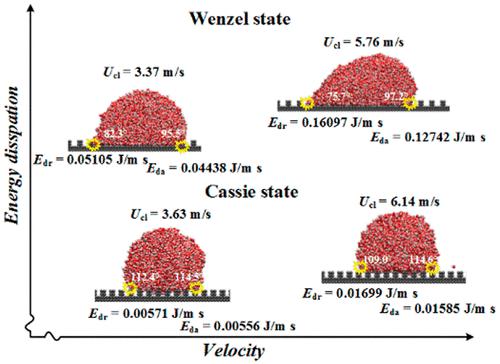Our official English website, www.x-mol.net, welcomes your feedback! (Note: you will need to create a separate account there.)
Velocity-Dependent Contact Angle and Energy Dissipations of Dynamic Wetting Nanodroplets on Nanopillared Surfaces
Langmuir ( IF 3.9 ) Pub Date : 2022-08-03 , DOI: 10.1021/acs.langmuir.2c00906 Chenxia Xie 1 , Jie Shi 2 , Yong Luo 2 , Guangwen Chu 2 , Hui Li 1
Langmuir ( IF 3.9 ) Pub Date : 2022-08-03 , DOI: 10.1021/acs.langmuir.2c00906 Chenxia Xie 1 , Jie Shi 2 , Yong Luo 2 , Guangwen Chu 2 , Hui Li 1
Affiliation

|
Dynamic wetting, described by a dynamic contact angle (DCA), is a fundamental behavior of fluid on surface. With the development of blue energy, the research of droplet nanogenerator is flourishing. There is a growing interest in the dynamic wetting behavior of nanodroplets on surfaces. Molecular dynamics simulations are performed to reveal the influence of the velocity of nanodroplets and the wetting state (Cassie and Wenzel) on the DCA and the energy dissipation on the contact line. The simulation results demonstrate a more complicated scenario of dynamic wetting than the static wetting: The increasing rate of advancing DCA is lower than the decreasing rate of the receding DCA with respect to the nanodroplet velocity. As for the Wenzel state, larger surface roughness increases the dynamic wetting hysteresis, while for Cassie nanodroplets, the larger surface roughness leads to smaller dynamic wetting hysteresis. It is found that a structural force exists on the rough surface. The energy dissipation of the dynamic wetting mainly comes from the motion of the contact line, which is positively correlated to the velocity and can be decomposed to the viscosity and friction dissipations, respectively. The Cassie state causes much lower energy dissipation than the Wenzel state. Furthermore, the quasi-static contact angle is proposed to describe the contact angle on a rough surface. These findings advance the understanding of dynamic wetting behavior and inspire theoretical guidance for the design of novel functional interfaces.
中文翻译:

纳米柱表面上动态润湿纳米液滴的速度相关接触角和能量耗散
由动态接触角 (DCA) 描述的动态润湿是流体在表面的基本行为。随着蓝色能源的发展,液滴纳米发电机的研究正在蓬勃发展。人们对纳米液滴在表面上的动态润湿行为越来越感兴趣。进行分子动力学模拟以揭示纳米液滴的速度和润湿状态(Cassie 和 Wenzel)对 DCA 和接触线上的能量耗散的影响。模拟结果表明动态润湿比静态润湿更复杂:相对于纳米液滴速度,前进 DCA 的增加速率低于后退 DCA 的下降速率。对于 Wenzel 状态,较大的表面粗糙度会增加动态润湿滞后,而对于 Cassie 纳米液滴,较大的表面粗糙度导致较小的动态润湿滞后。发现粗糙表面上存在结构力。动态润湿的能量耗散主要来自接触线的运动,它与速度呈正相关,可以分解为粘度耗散和摩擦耗散。Cassie 状态导致的能量耗散比 Wenzel 状态低得多。此外,提出了准静态接触角来描述粗糙表面上的接触角。这些发现促进了对动态润湿行为的理解,并为新型功能界面的设计提供了理论指导。动态润湿的能量耗散主要来自接触线的运动,它与速度呈正相关,可以分解为粘度耗散和摩擦耗散。Cassie 状态导致的能量耗散比 Wenzel 状态低得多。此外,提出了准静态接触角来描述粗糙表面上的接触角。这些发现促进了对动态润湿行为的理解,并为新型功能界面的设计提供了理论指导。动态润湿的能量耗散主要来自接触线的运动,它与速度呈正相关,可以分解为粘度耗散和摩擦耗散。Cassie 状态导致的能量耗散比 Wenzel 状态低得多。此外,提出了准静态接触角来描述粗糙表面上的接触角。这些发现促进了对动态润湿行为的理解,并为新型功能界面的设计提供了理论指导。提出了准静态接触角来描述粗糙表面上的接触角。这些发现促进了对动态润湿行为的理解,并为新型功能界面的设计提供了理论指导。提出了准静态接触角来描述粗糙表面上的接触角。这些发现促进了对动态润湿行为的理解,并为新型功能界面的设计提供了理论指导。
更新日期:2022-08-03
中文翻译:

纳米柱表面上动态润湿纳米液滴的速度相关接触角和能量耗散
由动态接触角 (DCA) 描述的动态润湿是流体在表面的基本行为。随着蓝色能源的发展,液滴纳米发电机的研究正在蓬勃发展。人们对纳米液滴在表面上的动态润湿行为越来越感兴趣。进行分子动力学模拟以揭示纳米液滴的速度和润湿状态(Cassie 和 Wenzel)对 DCA 和接触线上的能量耗散的影响。模拟结果表明动态润湿比静态润湿更复杂:相对于纳米液滴速度,前进 DCA 的增加速率低于后退 DCA 的下降速率。对于 Wenzel 状态,较大的表面粗糙度会增加动态润湿滞后,而对于 Cassie 纳米液滴,较大的表面粗糙度导致较小的动态润湿滞后。发现粗糙表面上存在结构力。动态润湿的能量耗散主要来自接触线的运动,它与速度呈正相关,可以分解为粘度耗散和摩擦耗散。Cassie 状态导致的能量耗散比 Wenzel 状态低得多。此外,提出了准静态接触角来描述粗糙表面上的接触角。这些发现促进了对动态润湿行为的理解,并为新型功能界面的设计提供了理论指导。动态润湿的能量耗散主要来自接触线的运动,它与速度呈正相关,可以分解为粘度耗散和摩擦耗散。Cassie 状态导致的能量耗散比 Wenzel 状态低得多。此外,提出了准静态接触角来描述粗糙表面上的接触角。这些发现促进了对动态润湿行为的理解,并为新型功能界面的设计提供了理论指导。动态润湿的能量耗散主要来自接触线的运动,它与速度呈正相关,可以分解为粘度耗散和摩擦耗散。Cassie 状态导致的能量耗散比 Wenzel 状态低得多。此外,提出了准静态接触角来描述粗糙表面上的接触角。这些发现促进了对动态润湿行为的理解,并为新型功能界面的设计提供了理论指导。提出了准静态接触角来描述粗糙表面上的接触角。这些发现促进了对动态润湿行为的理解,并为新型功能界面的设计提供了理论指导。提出了准静态接触角来描述粗糙表面上的接触角。这些发现促进了对动态润湿行为的理解,并为新型功能界面的设计提供了理论指导。


























 京公网安备 11010802027423号
京公网安备 11010802027423号